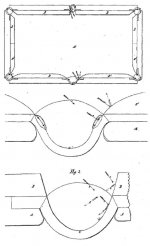Today, and for over 150 years now, American pool tables have "angled" pocket entries, unlike the snooker table which has rounded pocket entries. Of course this is due to how the cushions are attached and cut in a prescribed manor. But American tables were not always like this, believe it or not they used to have rounded pocket openings as well.
So, what happened? What, or who, was responsible for the major change?
Back in the early 1850s an enterprising fella by the name of Michael Phelan* decided that the American billiard table was due for a complete re-design. In the process, he incorporated several 'new' elements into his design which had never been featured on an American table before. And amazingly enough, these same elements are still with us to this day.
The diamond aiming sites that everyone is familiar with, were first placed on an American table by Phelan. The first 'countersunk' pocket irons were designed by Phelan. And, cushions that are angled at the pocket entry instead of rounded were first patented and installed by Phelan.
(Everyone else in the table business quickly followed suit)
But why did he do this? What's the advantage?
Phelan, who was taking a serious look at the science of angles and rebounds, wanted to fully eliminate any "chance" or " luck " which required (in his mind) getting rid of the scientifically 'unpredictable' rebounds that curved cushions produce.
"...it is peculiarly desirable to avoid all those uncertainties of play and deceptions of the eye and judgement which are caused by the gradual curve of the cushions as they approach the pocket jaws in the old style tables, it being impossible for the player to determine exactly where the curve begins or the effect it will produce on the reflective angle of an impinging ball. Therefore all strokes of this description made on the old style table are deprived to a great extent of their true scientific character and are thrown back into the category of chance(s)..."
He goes on to say that the corner pocket openings should be angled at about 45 degrees, and the side pockets about 10 degrees, or thereabouts.
In doing so, an increase of about 30 inches of rectilinear surface becomes available for play with a reliable, predictable angle of reflection or rebound.
The image below, from his 1858 patent, shows half of a table with the new angled cushions, and the other half with the old round style. (a new and old side pocket as well)
It makes me wonder what he thought about the actual width of the pocket opening relative to the size of the ball.

*along with his partner Hugh Collender and friend Dudley Cavanagh.
So, what happened? What, or who, was responsible for the major change?
Back in the early 1850s an enterprising fella by the name of Michael Phelan* decided that the American billiard table was due for a complete re-design. In the process, he incorporated several 'new' elements into his design which had never been featured on an American table before. And amazingly enough, these same elements are still with us to this day.
The diamond aiming sites that everyone is familiar with, were first placed on an American table by Phelan. The first 'countersunk' pocket irons were designed by Phelan. And, cushions that are angled at the pocket entry instead of rounded were first patented and installed by Phelan.
(Everyone else in the table business quickly followed suit)
But why did he do this? What's the advantage?
Phelan, who was taking a serious look at the science of angles and rebounds, wanted to fully eliminate any "chance" or " luck " which required (in his mind) getting rid of the scientifically 'unpredictable' rebounds that curved cushions produce.
"...it is peculiarly desirable to avoid all those uncertainties of play and deceptions of the eye and judgement which are caused by the gradual curve of the cushions as they approach the pocket jaws in the old style tables, it being impossible for the player to determine exactly where the curve begins or the effect it will produce on the reflective angle of an impinging ball. Therefore all strokes of this description made on the old style table are deprived to a great extent of their true scientific character and are thrown back into the category of chance(s)..."
He goes on to say that the corner pocket openings should be angled at about 45 degrees, and the side pockets about 10 degrees, or thereabouts.
In doing so, an increase of about 30 inches of rectilinear surface becomes available for play with a reliable, predictable angle of reflection or rebound.
The image below, from his 1858 patent, shows half of a table with the new angled cushions, and the other half with the old round style. (a new and old side pocket as well)
It makes me wonder what he thought about the actual width of the pocket opening relative to the size of the ball.

*along with his partner Hugh Collender and friend Dudley Cavanagh.